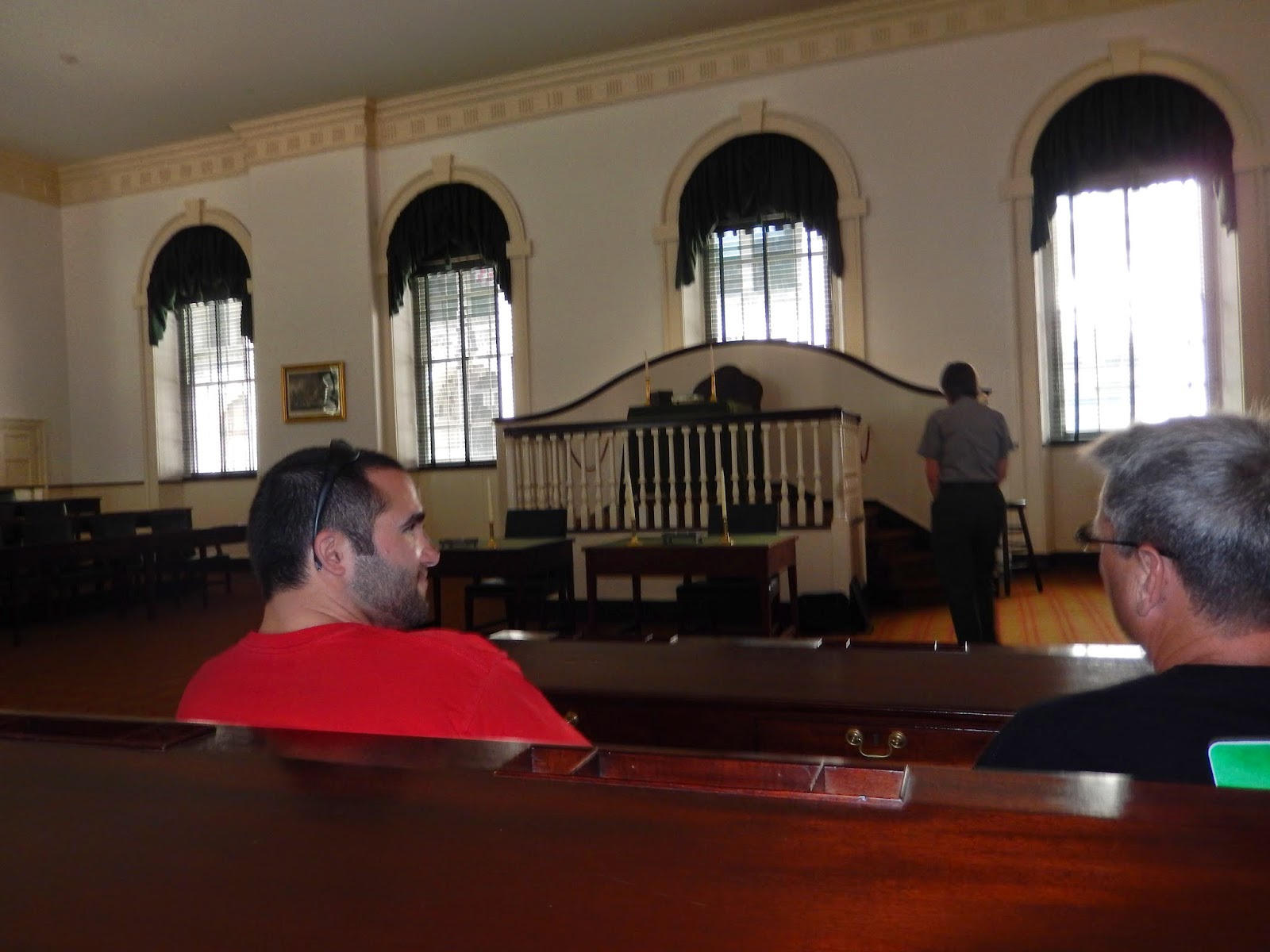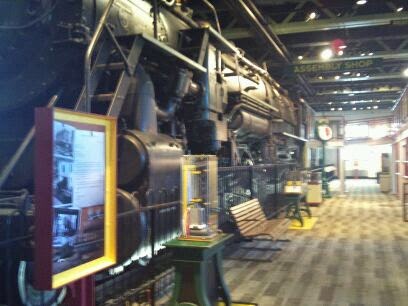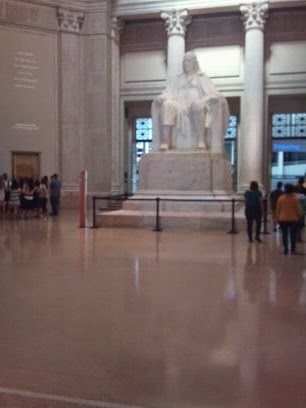I'm not much for taking photos when I travel. I'd rather experience where I am rather than document it with photos I might never look at again. But, I did manage to take a few photos on my visit to Philadelphia this summer. I went for two reasons, one personal and one professional. As a professor of English at Miami Dade College's Kendall Campus, I teach the American Literature 1-year survey courses, and with the Fall Term and American Literature 1 coming up,
Independence National Historical Park seemed like the place to go. Over a long weekend, I satisfied an old craving to see where this country started. Mostly, I wanted to see Independence Hall and whatever is left in the Old City regarding Benjamin Franklin's life there. So, here are some of the few photos I took as I walked around Old City.
Fig. 1: The Franklin Institute directly across Logan Square
One of the things I knew I wanted to visit was
The Franklin Institute. I've been there online many times, but like other things in this location, I wanted to see it with my own eyes. The top floor of my hotel provided a surprising image of the city. There was The Franklin Institute just blocks from my hotel on the other side of Logan Square (which is really a circle!). This beautiful view was a great way to start off my visit.
Fig. 2: One of several entrances to Logan Square
Logan Square turned out to be a lovely park surrounded by trees, dotted with benches for sitting, and crowned with a fountain with added surprises waiting as I drew closer.
Fig. 3: Tortoise sculpture in the fountain pool
A collection of animal sculptures circle the fountain's pool. I just had to have a photo of one of the tortoises as I have two friends who are particularly enamored of that reptile.
Fig. 4: Outside the Franklin Institute
The airplane sculpture near the entrance to The Franklin Institute caught my eye as I walked toward the entrance. As it turned out, I was too early, but was able to sit while I waited for the museum to open.
The exhibits inside are mostly for children, but it was fun wandering around. And, there are things there that I found interesting. First of all, I did know that steam engines had to be BIG. But, I had no idea how big until I stood next to one. There are three pictures below because it was just impossible to get the whole engine in one shot. It was enormous! The wheels are about as tall as I am.
Fig. 5: Steam engine
Have you ever wondered what it might be like to walk through a giant replica of the human heart? Well, I found out. It's cramped. I suppose that is just because the replica is made for children, but I did mange to get through the tight curves and steep stairs of
The Giant Heart while listening to the audio of a real heartbeat. The entrance is right around where that diagonal yellow line ends.
Fig. 6: Giant replica of a human heart
But, for me, the most important thing was to see The Benjamin Franklin Memorial. After wandering around the museum a bit, I found the famous statue and was amazed by its size. I deliberately put people in my photo just to show the scale of Dr. Franklin's statue and the hall that it dominates.
Fig. 7: The Franklin Memorial
I thoroughly enjoyed seeing the tribute to the great man I so admire.
As I left the Institute (after buying a Franklin pocket watch in the shop), I crossed back to Logan Square and another view of the city, the long stretch leading to City Hall.
Fig. 8: View of Philadelphia City Hall
On the Sunday of my weekend, I planned to spend the whole day in Old City. Independence Hall and the rest of Old City are an almost two mile hike from where I was staying. With some directions from hotel personnel, I started walking in the direction opposite that of Logan Square. So, what did I want to see? Independence Hall, of course. The Liberty Bell. Benjamin Franklin's home and gravesite.
It was hot, the walk was long, and I never did get to see the Liberty Bell up close, but I did find everything else. Well, sort of. My search for Franklin's home led me to Franklin's Courtyard, the part of Old City that he once owned. However, there is no house. I love old houses and think it's a shame that his did not come down to us, but the property is still there. An attempt has been made, however.
Fig. 9: Franklin's Court
These white frames show the placement and size of the original buildings. I walked through snapping these photos and went to the small museum and asked directions to Franklin's gravesite. Well, I asked after trying to find it on my own and getting nowhere! I walked my feet off that day in my quest for Franklin. Finally, I found it, too early again, but this time just a ten-minute wait until the gates of the
Christ Church Burial Ground were opened. I enjoy historic cemeteries, so I bought entrance and tour tickets to this amazing place.
The cemetery is the original burial ground for
Christ Church, which was founded in 1695. The current building dates from 1744 and is still an active church today. The weekend I was there, I could not wander around the building's interior any time I tried because it was closed for a wedding or services were being held. It was nice to see the old building still being used, but it gave me one reason for a return visit to Philadelphia some time in the future.
Finally I found the burial ground, quite a walk from the church, and Franklin's family plot. The tour proved very interesting.
A lot is known about most of the people who are buried there because a book was written,
The Edward Clark Inscription Book, that documented everything that was known at the time of publication.
Many important Philadelphians were members of the congregation and are buried in the cemetery.
Fig. 10: Gravesite of Dr. Benjamin Rush
To me, the most famous of the other signers of the Declaration of Independence, those I had heard of besides the obvious names, is
Dr. Benjamin Rush.
But, there are many "average" people buried here, too. Some grave stones are so old their inscriptions are completely weathered away. Many have sunken into the earth. Here are a few of the more interesting ones:
Fig. 11: The oldest grave (on the right)
The oldest grave at the site is worn away completely and much sunken into the ground. The sign in front of the two stones gives the inscription that was originally engraved on them. Again, while the inscription has been lost on the stones themselves, what was written there is known because of the book that was published. It has also been reprinted, so copies are available today for those who are interested.
Sometimes, with the permission of descendants and with the money to do the work, stones are raised to the proper level. Here are several stones that have clearly sunken.
Fig. 12: Sunken head stones
Fig. 13: Raised head stones
The horizontal lines on these two stones show the levels to which the stones had sunk. And, while their inscriptions are now visible, time and weather will take their toll until the sign will be needed again in order to read the inscriptions.
There are other interesting sights as well, notably, "tables" that family could use to set out food while visiting the grave of a loved one.
Fig. 14: "Table" grave stones
In addition to the oldest gravesite I mentioned earlier, there will also, one day, be a last gravesite, the last person to be buried at Christ Church Burial Ground,
Fig. 15: Last burial
The tour saved the most important grave at Christ Church Burial Ground for last, and so have I: Benjamin Franklin.
Fig. 16: Extended Family
The stone on the left in Figure 15 marks the grave of Franklin's father-in-law, John Read, who originally owned the plot. On the right is the marker for Francis, Benjamin Franklin and his wife Deborah's young son.
Fig. 17: Emma Bache
Franklin's daughter "Sally" married into the Bache family.
Fig. 18: Richard and Sarah Bache
Fig. 19: Benjamin and Deborah Franklin
The large stone over Benjamin and Deborah's grave is covered with coins. In the 19th century, brides started tossing coins on the Franklin's grave for good luck. Today, the money helps maintain the burial ground. While the inscription cannot be seen in this photo, it is very simple, little more than the names of both people.
So, my search for Benjamin Franklin was over. It was well after Noon, and I had a reservation for lunch at The City Tavern, quite a walk from my current location.
Fig. 20: The City Tavern
In keeping with my "experience it" rather than "photograph it" mentality during this trip, I didn't take any photos of the interior of the City Tavern, which dates from 1773, or my photos of my food to post on Facebook. But, I could well imagine Franklin and his Philadelphia friends enjoying a meal here. It's a wonderful, old building with authentic period food being served by a waitstaff dressed in period costume. I ate Colonial Turkey Pot Pie and a selection of breads, including biscuits made from Thomas Jefferson's favorite recipe. Dessert? Nothing other than Martha Washington's chocolate cake. I didn't think she would have had a recipe for chocolate cake, but there you go. Yum! Chocolate!
After being all worn out from walking around Old City and stuffed after a big meal, I headed back to my hotel, a 1.7 mile trek. Along the way, I stopped to photograph this wonderful building.
Fig. 20: The Philadelphia Academy of Fine Arts
Behind the pole on the right, you can just see the enormous paint brush peeking out. I was half-way back to the hotel by now, and really looking forward to a little rest.
What about Independence Hall, you ask? Coming up!











































